Okay, today we look at a Biggie......Theee (****Drums roll****) Taaaj Mahaaal (****Applause****). Everyone may not consider it so great, but then, it makes a regular appearance in every new list of Wonders of the World (Unfortunately, it was not around when the original list of 7 Wonders were compiled. The pyramids at Giza are the only one surviving out of those).
So, last monday, we drove down to Agra with my cousin who had come over from Mumbai. Chose a monday as I did not want to go on a weekend, with the entire NCR crowd there on a weekend picnic.
The ideal time to leave Delhi would be early morning, so that we cross the DND flyover and Toll Booth before 0800. But taking a holistic approach regarding convenience and the fact that we had a small baby with us led us to leave our home at 1100. Traffic, within Delhi, as usual was heavy. Took us an hour to get onto the Greater Noida Expressway. It was a great road. And for the first time, I realised just how huge Greater Noida is, and how far it is from Delhi proper. But the GNE was nothing compared to the Yamuna Expressway. It was a joy to drive on. A broad road with very sparse traffic.
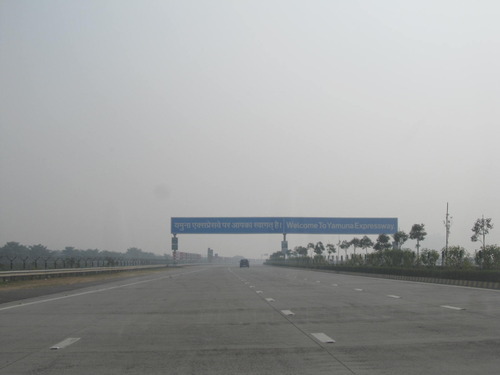
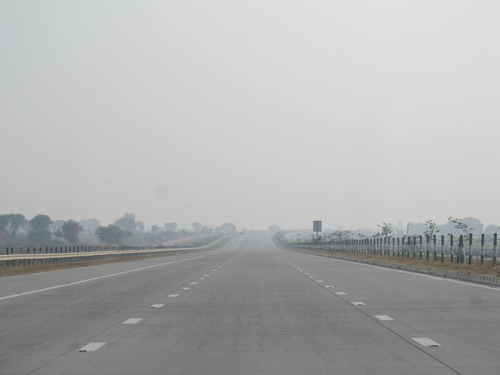
It took us just 3 hrs to reach the outskirts of Agra, in spite of two longish breaks. But then, it took us almost an hour inside Agra to reach our guest rooms.
Our accomodation was just a few minutes from Agra Fort and the Taj Mahal. We just put our luggage in the room and immediately went to the Agra Fort.
AGRA FORT
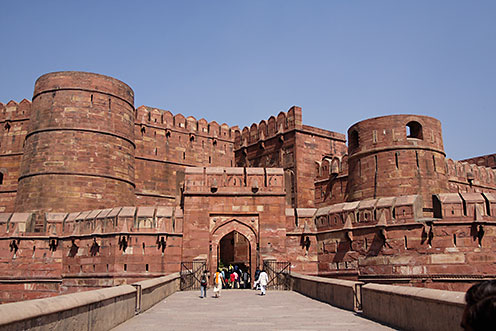
The Agra Fort is a huge Red Sandstone structure lying on the banks of the river Yamuna.
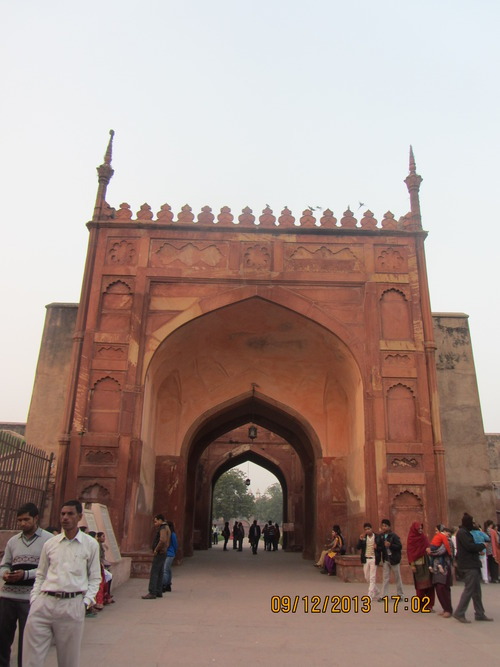
*****BORING/ INTERESTING HISTORY*****
The first mention of this area is in 1080 AD when the Ghaznavis captured a brick fort from the Chauhan Rajputs. Sikandar Lodhi, in the 15th century, was the first Sultan of Delhi to shift to Agra and rule from here. His son, Ibrahim Lodhi was defeated by Babur at Panipat in 1526, who then captured the Agra Fort, along with the great treasures in it. The Koh-i-noor diamond came into possession of the Mughals here (more about it later). This was followed by some musical thrones - Humayun - Sher Shah Suri - Hemu. And finally Akbar put an end to it by decisively defeating Hemu in 1556 at the Second Battle of Panipat.
Realising the central position of Agra, Akbar decided to make it his capital and commenced building the Agra Fort.The present fort dates back to this period. It was completed by 4000 workers, working everyday, in eight years. The fort was built with red sandstone and according to Abu Fazl, the court historian, contained over 5000 buildings within the complex. (Today, only 30 odd building from the Mughal period have survived. Many were destroyed by Shah Jahan for building his marble palaces and the rest by the British for building their favourite type of structure, barracks.)

Akbar's successor, Jahangir, continued to govern the country from Agra. But hardly stayed here as he spent most of his time in Lahore and Kashmir.
The next emperor, Shah Jahan, was a great builder and built many palaces here. Unlike Akbar, his favourite construction material was marble. Of course, we will visit his Magnum Opus, The Taj Mahal, in a few paragraphs. Shah Jahan shifted the capital back to Delhi when he built the Red Fort. But he spent a large amount of his time here.
And, of course, when his son, Aurangazeb took over in a coup-de-etat, he was imprisoned in this fort. It was more like a forced retirement, rather than imprisonment, as the fort was quite luxurious and he was permitted to move around it freely. He died in the fort, looking at the Taj Mahal across the river.
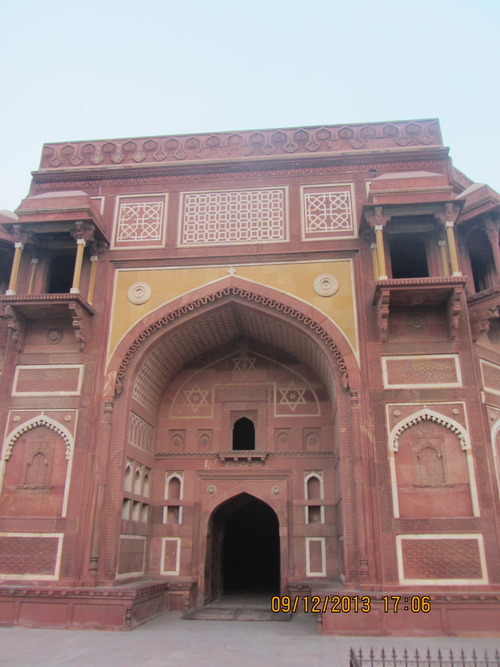

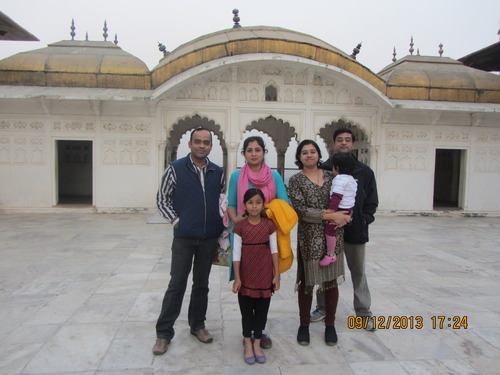

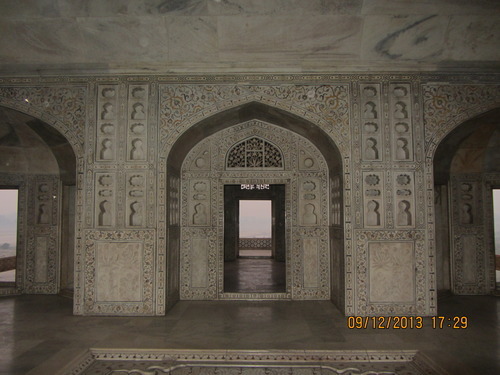
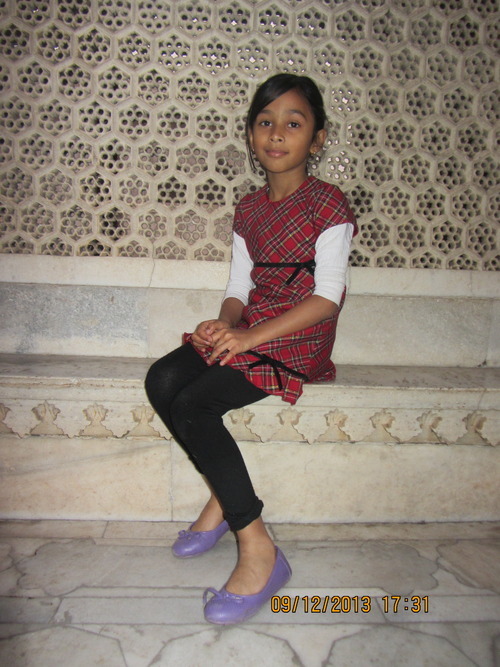



Aurangazeb also used this fort for keeping another star prisoner, Shivaji. He famously escaped from his clutches from this fort to cause Aurangazeb tremendous grief and trouble.
After Aurangazeb, Agra rapidly went downhill. It saw a series of sieges and was plundered by various regional powers. The fort shifted hands between the Marathas, Jats, Rohillas, Afghans, Mughals, etc for a while, before the British defeated the Marathas in 1803 and took over the fort.
As can be seen, the Marathas were a major player here as well. In fact, the only statue in front of the main entrance of the Agra Fort is that of Shivaji. Of course, it was erected in early 2000s by the BJP govt, probably as a symbol of hindu resurgence.
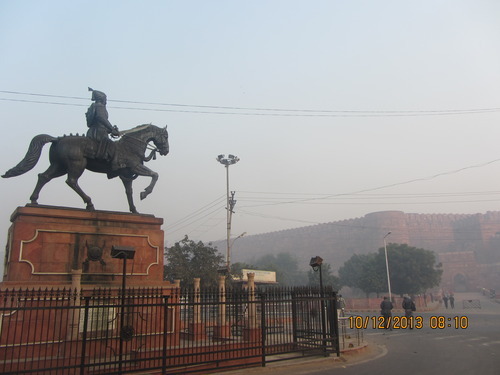
That ends the story of the Agra Fort.
*******History Ends*********
*******The Kohinoor Diamond********
In an earlier post on the Red Fort, we had seen the history of the Peacock Throne. The History of the Kohinoor, the centrepiece of the throne, is even more chequered.
This diamond is believed to have originally come from a mine in Andhra Pradesh and was a massive 793 carats when uncut. The early history and ownership is not certain as it was not called by the name, Kohinoor. The original owners were probably the Kakatiyas or Rajah of Malwa. It was taken by the Khiljis when they defeated them in early 1300s. It then passed on to the Tughlaqs followed by Lodis. Babur took it from Ibrahim Lodi when he took the Agra Fort in 1526. Shah Jahan added it to the Peacock Throne which was taken by Nadir Shah of Iran in 1739 (He is the first one to call it Kuh-e-nur, 'The Mountain of Light'). The Durranis of Afghanistan took it from Nadir Shah when he was assasinated. Ranjit Singh took it from the Durranis in 1830. And finally, the British, under Lord Dalhousie, forced the Sikhs to give it to Queen Victoria, as spoils of war, in 1849.
The original stone remained uncut till Aurangazeb commissioned a Venetian lapidary, Hortenso Borgia, to cut it. He was so clumsy that he reduced the size to 186 carats. As can be seen from the illustration above, it didn't look very....diamondish. When the British public first saw it in the Great Exhibition of 1851, everyone was very disappointed by its plain appearance and lack of brilliance and sparkle. So the stone was recut under the personal supervision of the Queen in 1852 to increase its brilliance, and was reduced to its current 105.6 carats (21 gms).
It is now a part of the State Crown of Queen Elizabeth and is placed in the Tower of London for display.
So how expensive is the Kohinoor. There is no way to put a value to it as it has never been bought, only plundered, stolen or gifted (under coercion). Just for an idea, the most expensive diamond sale ever documented was the Graff Pink, sold in 2010, for $46 million. This diamond was 24.78 carats, compared to Kohinoors 105 carats.
******************************************
We could only take a quick walk through the fort as it was getting dark and closing soon. But it was a magnificent fort, and without doubts, worth a leisurely visit in the future. I will leave the description of the insides in more detail for that visit.
Continue reading Part 2...........










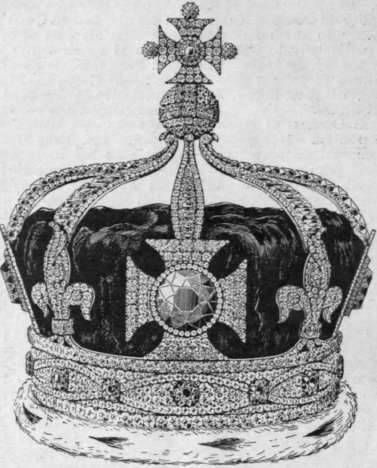










Very nice historical blog post, Nitin! Do you ever wonder how life was a 1000 years ago?!
ReplyDeleteI read your blog. Such a great information. If anyone wants to Cheap Flight From Delhi to Boston then come with us and get Cheap Flight From Delhi to Boston in Unbeatable price.
ReplyDeleteI read your awesome blog. I really like this blog. If anyone wants to Cheap Flight From Delhi to Boston then come with us and get Cheap Flight From Delhi to Boston in Unbeatable price.
ReplyDeleteGood Blog with good Pictures, i really like it.We provides Tempo Traveller on rent, Tempo Traveller in Delhi ,Tempo Traveller in Delhi ,Tempo Traveller in Gurgaon , Tempo Traveller on rent in Noida , Tempo Traveller on rent in Ghaziabad , Tempo Traveller on rent in Faridabad , Tempo Traveller,Tempo Traveller rent faridabad,Tempo Traveller on rent in gurgaon,Tempo Traveller hire Ghaziabad,Tempo Traveller rental faridabad,Tempo Traveller on rent in noida ,Tempo Traveller on rent in Ghaziabad for easy travel.
ReplyDeleteThanks for providing this informative and comprehensive blog. This is very interesting article. The pictures are really beautiful and the way you explained about the places to visit. For travelers, we provide taxi services in all over India, more details visit our sites:- Taxi Services in Mathura, Taxi Services in Allahabad , Taxi Services in Vadodara, Taxi Services in Delhi, Taxi Services in Rameshwaram .
ReplyDelete